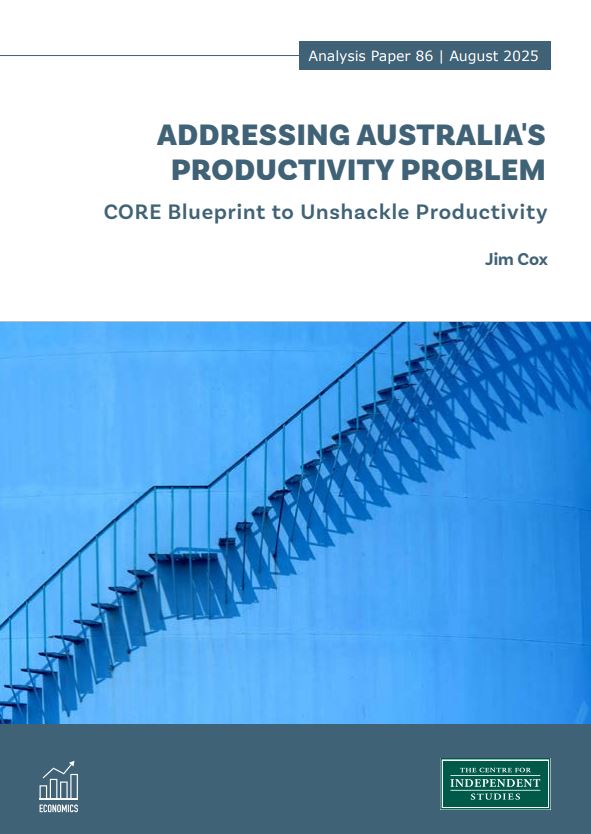
Introduction
There is no one action that will lift Australia’s dwindling productivity growth; it is a measure determined by a multitude of factors including technical advances, innovation, entrepreneurship, education, training and up-skilling These factors are influenced, but not determined by, many government actions. These include government spending, industrial relations policy, regulation, competition and tax policies, as well as energy policy.
Reports by the Productivity Commission, the OECD and committees of inquiry have identified policies that might be effective in increasing productivity, but these recommendations have not always been acted upon. All these issues will be part of roundtable discussions called by Treasurer Jim Chalmers on economic reform and productivity in August, 2025 .
However, many reforms are dependent on the working of Australia’s regulatory system and its effectiveness for their success. Although the objectives of regulation are desirable, insufficient attention has been paid to the resulting effect on innovation and productivity.
For this reason, we consider Australia’s governments should legislate to introduce a Charter Of Regulatory Effectiveness.
This would have four major objectives:
- Facilitate decision-making. Regulators should be given a responsibility to be stewards of the legislation they administer. This should involve keeping the legislation up to date (or advising ministers to do so) and — equally as important — removing obsolete, duplicative and unnecessary provisions.
- Streamline the process. The principles of effective regulation should be codified in legislation with emphasis on the importance of encouraging innovation and productivity growth and timely approvals.
- Accountability. Responsibility for the regulatory system as a whole should be assigned to suitable ministers and public service departments who should report periodically to parliaments and the public on the effectiveness of the regulatory system.
- Oversight. Ex post reviews should be undertaken of the effectiveness of regulatory systems in particular areas of policy.
These proposals build on those that already exist and, if followed consistently, will result in continuing improvement in regulatory systems. In particular, they will encourage greater innovation and faster productivity growth.
This thinking is supported by the Productivity Commission’s interim report to the government prior to the Treasurer’s roundtable (PC, 2025c). The report highlights the need for more effective regulation, noting that Australia had fallen on key international regulation indices. “We have most of the tools and procedures we need to regulate well, but they are just not working,” the commission reports.
It recommends the government provide a more effective counterweight to risk aversion and incentives that have created a thicket of regulations and rules. “It should adopt a whole‑of‑government statement to commit to regulation outcomes that better promote growth and dynamism, and lead by example by outlining a series of productivity enhancing reforms,” the report says. “There should be increased scrutiny of regulatory proposals from Cabinet, parliament and a newly appointed independent statutory commissioner for the Office of Impact Analysis.”
The commission also recommends regulators and policymakers be more proactive in managing regulations and better consider the trade‑offs between regulatory objectives, risk tolerance, compliance costs, and broader economic growth. “[Regulators] should be empowered to regard themselves as stewards of the regulatory systems they manage and be accountable for delivering outcomes.”
The benefits of better regulation has been a discussion point in Australia since the recent release of the book, Abundance, by Ezra Klein and Derek Thompson (Klein and Thompson, 2025). The authors criticise US review processes and regulations surrounding housing, infrastructure and healthcare. In each case, regulation has had the effect of slowing progress and making delivery more costly.
The political economy of productivity growth
Productivity growth is influenced by a number of factors outside of government policy. The key drivers are production and investment decisions by companies, as well as employees, managers, investors, suppliers, and consumers. Decisions by individuals, firms, not for profit organisations and government agencies also are relevant.
One consequence of this decentralised decision making is that we cannot guarantee that a particular productivity-enhancing policy will increase economic growth by a particular amount. As so often in economics, we are discussing general tendencies here: one set of policies is more likely to result in faster productivity growth than an alternative, but we cannot be certain in advance.
By contrast, a government decision to increase a benefit by a certain amount will immediately increase the incomes of recipients by the amount of the increase. Uncertainty about the consequences of policies to increase economic growth has led some economists to conclude that economic growth should not be emphasised as a policy objective because we do not know how to achieve it (e.g. Banerjee and Duflo, 2019). However, this conclusion ignores much historical evidence regarding the circumstances most likely to generate economic growth, including recent historical experience. Despite the uncertainty of results, policies to increase productivity growth are always worthy of advocacy.
It is sometimes suggested that a lack of political will is the reason productivity-enhancing policies have not been adopted. Political courage is to be welcomed but cannot be relied on. Governments have limited political capital which they tend to use cautiously. Measures to increase productivity are not always liked. I remember being told, when advocating a policy to the New South Wales government that “you are probably right but we don’t like it that you are right”.
There are two issues here that were discussed in my previous paper The Productivity Problem. The first issue is that, while productivity growth is a source of economic growth, many people may wish to prioritise other objectives (such as redistribution, security, or environmental objectives). Australia has had a period of prosperity during the early decades of the 21st century. So it is not surprising that many people favour policies that advance non-economic objectives. The difficulty is that these policies may weaken productivity growth even if this is not the intention.
The second issue is that the benefits of productivity growth are widely dispersed, including to future generations. By contrast, any adverse effects of policies to improve productivity growth are more likely to be concentrated on groups in the present, who may oppose the measures, even if the overall effect is beneficial.
These issues reflect the diversity of values that society wishes to progress through public policy. To some extent, these values may conflict with each other; as noted by Isaiah Berlin (1994) “not all good things are reconcilable with each other”.
Compromises and trade-offs between economic security and productivity growth are therefore necessary and can be developed over time. Productivity growth has been less emphasised in recent years, but there are some scenarios available to illustrate how the balance might be redressed.
The first, pessimistic, scenario involves continuation of politics as usual until a crisis requires policies to be reconsidered. Concern by foreign investors over the size of a country’s government debt is an example of such a crisis. However, I do not think this scenario is a realistic one for Australia because of the generally satisfactory condition of our public finances (despite rising Commonwealth and State government debt) and Australia’s history of adaptability that suggests that action would be taken long before a crisis occurs.
A more realistic scenario points to the self-correcting tendencies in a democracy (see Meltzer, 2012). This view points to a tension between redistributive policies, which increasingly favour the middle class, and policies that promote economic growth, such as reduced tax rates and less regulation. The recent increase in incomes (and especially high incomes) and wealth, and the experience of COVID-19, may have resulted in middle class voters favouring additional redistribution. However, we are now in a period where concern about Australia’s economic performance is increasing, as it did during the late 1970s during a period of high inflation and rising unemployment . This concern may lead to a change in the priorities of middle-class voters to favour economic growth. This plausible scenario is consistent with Australia’s history.
The third and most optimistic scenario indicates that it might be possible to develop a grand compromise which attracts widespread support in which policies to promote productivity growth are combined with environmental and redistributive policies. This approach may seem optimistic but reflects the policies that were implemented in the 1980s in response to low productivity growth in the 1970s.
It is therefore reasonable to suppose that there will be increasing demand for policies to promote productivity growth during the next few years. The task of policy analysis is to develop clarity on which policies are most likely to be effective so they can be available for adoption when the occasion arises.
We have emphasised that the development of public policy involves trading off competing but desirable objectives. This is an important point because much public discussion ignores trade-offs by concentrating on one objective only. On this point, the development of good public policy would be assisted by more information made available to the public about the alternatives available and what is involved in the choice. Energy policy in Australia recently provides an example where more such information would be beneficial. Moreover, as noted in my previous paper, in the longer term a more productive economy can provide greater environmental protection and more assistance to the disadvantaged and disabled than a less productive economy. This important point should be considered in making decisions.
Policies to enhance productivity growth
We now turn to a discussion about which policies are most likely to enhance productivity growth. In addition to the Productivity Commission’s interim report, other useful guides are provided by the commission (PC, 2023) and the OECD (Andre and Gal, 2024). The Productivity Commission also has recently released an interesting study that demonstrates that the way in which the housing industry is regulated has contributed to declining productivity in the sector (PC 2025a).
A recent report by CEDA (CEDA, 2025) argues that taxation, occupational licensing and land use regulation encourage small firms to be dominant in the construction industry. However, small firms are less productive than large firms in this industry.
There are many policies that could assist productivity growth. However, we must set priorities or else the issue will seem too hard to address. Subsequent reform efforts can be considered once the initial priorities have been achieved.
In considering which policies are most likely to be successful in generating faster growth it is, I think, useful to organise thoughts around the main determinants of productivity growth that I identified in The Productivity Problem. These are the skills and attributes of the population (including the quality of management), the amount of public and private investment that occurs, and the amount of innovation.
Education and training
Education and training can be provided on the job as well as in educational institutions and it is important to recognise that these can be alternatives.
The skills that will be required in future are uncertain because technologies, government policies and the goods and services that people wish to purchase are all subject to change. As far as possible people should be provided with the capacity to navigate the challenges that lie ahead.
The most important point is that schools should provide the foundation in terms of literacy, numeracy, and scientific understanding of the world on which later training and work experience can build. The last few years have been difficult ones for school education. The COVID-19 pandemic and the response to it have disrupted the education of students who were at school during that time. Australia now has a problem of low school attendance (ACARA, 2024).
The results of standardised tests point to deteriorating performance compared to Australia’s own past performance and the performance of overseas countries. However, there seems increasingly to be agreement that a well-defined (but not overloaded) curriculum and methods of teaching by direct instruction can improve performance. Particular attention should be paid to students who are starting to lag their peers.
Post- school education (i.e., tertiary and technical and further education) should continue to expand and respond to the changing needs of the economy. The manual skills required to deal with the physical world will continue to be required. The emphasis in tertiary education should be to build a foundation on which later training and work experience can be based. Social and managerial skills as well as technical skills will be important. Ideally, post-secondary education will not be too narrowly technical.
Adult training can be provided either by educational institutions or on the job. This raises the question of who benefits and who pays. According to Gary Becker (1993) we should distinguish between firm-specific and general training. Firm-specific training benefits the firm that is doing the training, but not other firms. The firm itself can be expected to pay for firm-specific training. By contrast, general training is of benefit to firms other than the one doing the training. This firm is unlikely to want to pay for the training which must therefore be paid for by the person who is being trained or by the government through subsidies.
There is understandable concern that non-compete clauses in employment contracts limit the mobility of employees between firms and slow down the diffusion of innovative ideas and techniques between firms. As a result, governments may limit the use of non-compete clauses in employment contracts. An implication of this change is that training that was previously firm-specific will become less so and more like general training. Formal training and government subsidies to training may need to be augmented in this environment.
Skilled migration to address shortages has been a long-standing and successful component of Australia’s immigration policy and should continue to be emphasised. Occupational licensing prevents best use being made of the skills available in Australia. For example, mobility between states is likely to be limited if each state has its own requirements. There is a case for occupational licensing to ensure that health and safety requirements are met. But care needs to be taken to ensure that these restrictions are no more onerous than they need to be. The Commonwealth government has announced its intention to “work with states, territories, businesses, and unions to design a national licensing scheme for electrical trades people” (Chalmers, 2025). Further consideration of changes in occupational licensing seems to be justified.
There is much evidence to suggest that providing pre-school education to the least advantaged children provides a substantial productivity dividend in later life.
So far, we have been discussing how education and training provides people with the skills and attributes needed to navigate economic change. A well-functioning health system, with an emphasis on preventative health, is also important.
Private and Public Investment
There are many determinants of business investment, not all of which are easily influenced by government policy. As Keynes noted, investment decisions depend on business people’s animal spirits — their sense of optimism or pessimism in facing an uncertain future.
Nevertheless, there are things that governments can do to improve the environment in which investment decisions are made. One of the most important is fiscal restraint to prevent the amount of government debt from growing excessively. Fiscal restraint requires careful control over the growth of government expenditure, and tax increases where necessary.
Interest rates must be sufficient to lead investors to hold the amount of government debt that exists. The higher the amount of government debt the higher interest rates are likely to be over the longer term, all else equal. This is important because the government bond rate is the benchmark against which other investments are judged, for example when using the much-employed Capital Asset Pricing Model. Indeed, the government bond rate is often referred to as the risk-free rate although it is not entirely without risk. An increase in the government bond rate is therefore likely to flow through to the evaluation of other investments in the economy and discourage investment in general.
Government expenditure should be reviewed to ensure that its purpose is clear and that it is effective in achieving its purpose. Ineffective government expenditure should either be modified to make it effective or should be discontinued.
In a recent CIS Analysis Paper, Robert Carling (2025) argues that “above a certain level, bigger government tends to be associated with lower productivity growth, slower economic growth and slower advances in living standards”. This is because higher government spending must be financed through higher taxation or more borrowing, each of which has adverse economic effects. Higher government spending draws revenues from the private sector and encourages unproductive activities such as lobbying. Carling argues that higher government spending changes the nature of society by discouraging entrepreneurship and voluntary activity and encouraging “politically based jockeying at the expense of others”. He recommends that fiscal rules should be reinvigorated including a program of rolling expenditure reviews.
Australia’s reliance on personal income taxation may increase further if fiscal restraint requires an increase in taxation. Marginal tax rates (the amount of additional tax that is paid if additional income is earned) matter most for productivity since they influence the incentive to earn extra income. Australia’s income tax rate for incomes between $135,001 and $190,000 is 37 cents in the dollar plus the Medicare levy of 2%, and the marginal tax rate for incomes of $190,000 and above is 45 cents in the dollar plus the Medicare levy. Compared to most other OECD countries. Australia’s top rate of personal income tax is payable at relatively low multiples of average incomes.
To avoid discouraging productivity growth through over reliance on personal income tax, consideration could be given to increasing reliance on other tax bases. For example, it has been suggested recently that greater reliance should be placed on the goods and services tax, land tax, road user charges (to replace the excise on petrol which is a declining source of revenue) or carbon taxes.
A reduction in the statutory rate of company tax might also increase investment. Australia’s company tax rate of 30% (25% for businesses with a turnover of less than $50 million) is high by international standards. Rates of 20 to 25% are more common. For example, the US Tax Foundation has calculated that average corporate tax rates (weighted by GDP and allowing for the global minimum tax) were 25% in Asia, 24% in Europe and 26% in North America in 2024 (Tax Foundation, 2024).
An imputation system exists for company taxation in which, for Australian residents, company tax paid is credited against personal income tax otherwise payable. This means company tax is effectively a prepayment of personal income tax, and it is personal income tax that influences incentives to invest. Overseas taxpayers are liable for company income tax in full.
The review of taxation undertaken by the Henry Committee (Henry, 2010) argued that investment is particularly supported by lower company tax rates. It recommended, therefore, that the company income tax rate should be set towards the lower end of the small to medium OECD economy average, with a reduction to 25% over the medium term. It added that “this aims particularly to increase the level of business investment across all sectors, including foreign direct investment; promote more entrepreneurial activity; and reduce incentives for profit shifting offshore”. Productivity could be lifted through more efficient and neutral taxes including streamlined and enhanced capital allowance arrangements and improved treatment of business losses. The committee also suggested further consideration of a business level expenditure tax and the future of dividend imputation in an internationally integrated economy.
Public investment in infrastructure (which includes roads and public transport, water, sewerage and drainage, education, and health facilities) is required to support productivity and a growing population. As discussed in The Productivity Problem, public investment has remained broadly constant as a proportion of GDP in recent decades. This investment should be directed to areas of greatest returns for society rather than being of particular benefit to influential constituencies. Similar issues arise in highly regulated industries with substantial monopoly power and where the costs of making investments would be recovered from all consumers if the regulator allowed the cost of the investment to enter the regulatory asset base.
The greater scrutiny of infrastructure investment decisions in recent decades by agencies that report to the public has been beneficial in improving the decisions themselves and public confidence in decision making. This scrutiny of investment decisions is provided most effectively by the independent regulators of infrastructure providers which assess potential investment decisions using a consistent cost-benefit framework and report to the public on the results of their assessments.
Reduced scrutiny applies elsewhere. Organisations such as Infrastructure Australia and its state government counterparts such as Infrastructure NSW provide expert advice to governments and report to the public on the progress of infrastructure projects. Auditors-General increasingly report to parliament and the public on the efficiency with which infrastructure projects are undertaken.
Governments can, if they wish, circumvent the scrutiny which regulators would otherwise provide by passing legislation to exempt certain projects. Productivity growth would be encouraged, however, if exemptions can be kept to a minimum.
Innovation
Because of the close association between innovation and productivity growth, the most important issue to consider is how government policy can encourage innovation.
It is natural to think of subsidies and tax concessions as a way of encouraging innovation, but these measures should not be over-emphasised. This is for two reasons. First, successful innovation requires not only changes in techniques but also changes to marketing and the organisation of production. Subsidies may, to a considerable extent, reward activities that would have occurred in any event. To the extent to which this is not the case, subsidies may distort innovation from its most productive channel. Secondly, subsidies and tax concessions encourage a close relationship between business and government in which resources are directed to influencing government decisions. This is unlikely to be the most productive use of these resources from the point of view of society.
For example, given the slow growth in manufacturing productivity recently, measures to encourage manufacturing might have reduced the productivity of the whole economy.
However, governments should undertake activities that would not otherwise occur, (such as non-commercial research and development) and ensure that the results of this work are made easily available to the public.
Incentives for Innovation
In general, innovation is encouraged by open and competitive markets where the rewards of successful innovation are substantial and where the benefits of innovation are, at least over time, distributed equitably. Australia’s well-targeted social safety net has limited the growth of inequality of incomes in recent years (see PC,2024).
An actively competitive market, including for digital and data dependent services, spurs participants to innovate. Imported goods and services and foreign investment provide an important source of competitive pressure. Customers may choose to purchase imported goods and services if they find them preferable to those locally produced. Foreign investment facilitates the introduction of new methods of production and new management techniques. International evidence indicates that openness to international trade increases competitive pressure and multifactor productivity (Andre and Gal, 2024, page 48). The recent increases in tariff and non-tariff barriers in overseas countries is therefore cause for concern. However, productivity would be adversely affected were Australia to increase its own barriers to international trade and investment.
Active implementation of competition policy will encourage innovation. Competition policy aims to prevent trade practices that limit the competitive spur to greater productivity and efficiency. Recent changes requiring the Australian Competition and Consumer Commission to scrutinise a larger number of mergers for anti-competitive effect are therefore welcome (ACCC, 2025), although some commentators are worried about the associated compliance costs. Moreover, because competition policy is now so active, the remaining limits to competition in our economy are likely to stem, to a considerable extent, from government legislation.
Intellectual property regimes, such as patents, are another important aspect of innovation policy. The protection of intellectual property for a period encourages innovation in the first place but tends to impede its subsequent diffusion to firms that lag the efficiency frontier. Unduly extensive and complex combinations of patents (‘patent thickets’) slow diffusion. Noting that there is an international dimension to intellectual property, a balance needs to be struck between these considerations. An alternative (and under-utilised) approach to encouraging innovation is for the government to offer prizes to successful innovators, who would then make their intellectual property generally available.
As previously discussed, personal income tax should not discourage innovation unnecessarily. It should not become so onerous that people are discouraged from taking the risks required for innovation. Australia’s high marginal personal income tax rates have already been noted. The Henry tax review argued that savings for investment would be encouraged by more efficient and neutral arrangements, including a common 40% discount for interest, net residential rates and capital gains, and revised taxation arrangements to take “Australia’s superannuation system towards its logical conclusion — as a subsidised expenditure tax. This is important because there has been concern that superannuation has undergone constant change” (Henry, 2010, page xxii). By contrast, recent and proposed changes to the taxation of superannuation are of an ad hoc nature.
Many attempts at innovation are unsuccessful, often because of bad luck. It may be impossible to estimate the likely success of an innovation before it is attempted. Given this, insolvency provisions should encourage a timely exit of unviable firms and the allocation of resources to more productive uses. OECD data (Andre and Gal, 2024, page 56) indicate that, while the situation in Australia is improving, compared to other countries there may be scope for further improvement.
In highly regulated industries, some regulators provide incentives for innovation by basing forecasts for capital and operating expenditure on an assessment of efficient costs. Firms that spend less than the regulators’ forecasts will benefit while those that spend more than the forecast amounts may earn a lower-than-expected return on their asset base. In this way regulators can provide a continuing incentive for innovation.
Policies to increase the capacity to innovate
Governments should provide for basic research that would not otherwise be undertaken and disseminate the results. Collaboration between researchers, government agencies and industry is important. Governments also collect and hold data and information and must consider how best to make this information available to facilitate innovation. It is important to make the results of trials undertaken by government agencies widely available.
Access to finance is required to support the development of innovative activities. Active and deep capital markets, including for venture capital, are needed. However, innovation is risky. Following the Global Financial Crisis there is understandably a desire that Australia’s banks should be unquestionably strong. However, regulation should be reviewed periodically to ensure that it does not excessively limit innovation. A related issue is ‘short-termism’ — an excessive focus by investors and managers on relatively quick financial results. The owners of firms, who have an interest in increasing the value of their investment through innovative activity, are best placed to address this issue.
Another capacity required by an innovative firm is the capacity to attract and retain labour. Occupational licensing should be reviewed to ensure that it is no more stringent than it needs to be for safety and health reasons. Employment protection legislation protects employees from unfair dismissal but limits the ability of firms to restructure employment following changes in technology and demand, and to experiment with new business structures. Care therefore needs to be taken to avoid excessive levels of employment protection.
Cheaper housing would make it easier to attract and retain employees who can move close to where job opportunities exist and avoid long journeys to work. The high costs of moving house, for example stamp duty, are relevant here. Recent CIS papers (for example, Tulip, 2024, and Donovan, 2025) have examined the high cost of housing and argued for re-examining land use restrictions and increasing housing supply.
Removing barriers to innovation
Regulation has been designed to address objectives such as the control of monopoly power, consumer protection, safety and security, and protection of the environment. However, regulation can easily have the effect of discouraging innovation. Care should be taken to ensure that the benefits of regulation exceed the costs. This requires good understanding of the trade-offs between competing objectives and thoughtful choices about where to strike the balance. The institutional framework should facilitate weighing the costs and benefits of alternative standards; situations where standard-setters can ignore the costs that they impose on businesses and consumers should be avoided.
In network industries, such as energy, there is a further balance to be struck between reducing costs to the consumer in the short term and maintaining a strict separation between electricity networks and electricity generation to encourage entry and competition in generation. The ownership and operation of batteries by electricity networks is a good example of this tension which requires consideration on a case-by-case basis.
Energy is fundamental to economic activity and high energy costs will discourage economic activity and innovation. Energy policy should aim to strike a good balance between the objectives of emissions reduction, reliability and security, and low prices. The emphasis should be on increasing supply. All sources of supply should be considered, although there are barriers to the adoption of nuclear power in Australia.
Energy policy should respond to technical advances which may change the relative attractiveness of technologies.
Environmental standards have two effects on productivity. Some firms may innovate to meet enhanced environmental standards. This will improve productivity. However, other firms may cease production or become less productive, thus reducing economic output. To minimise adverse consequences, environmental regulation should be consistent and predictable. Policy uncertainty should be minimised to the extent possible.
Similar issues arise in setting minimum or award wages. Productivity may be reduced if minimum wages are raised too far or too rapidly. Moreover, there may be consequences for inflation or unemployment in the longer term if wages growth far exceeds productivity growth.
To encourage innovation, particular care should be taken with regulation that affects new business entrants. This includes business licensing, occupational licensing, and care in setting product standards so as to not unnecessarily exclude new entrants.
A Charter of Regulatory Effectiveness
An important conclusion from the discussion in this paper is that regulation can impede innovation and productivity growth. To make administration possible, simplified categories must be imposed on a more complex reality. The difficulty is that innovative proposals, by their nature, do not fall within existing categories and their progress may be made more difficult by regulation.
Policy to improve productivity growth therefore needs to consider how to improve regulation. This is not to question the objectives that regulation seeks to achieve. However, we need to ensure that these objectives are pursued in a way that does not involve too large a reduction in productivity growth. Australia already has many elements of regulatory review. However, this program needs to be strengthened and focused to a greater extent on innovation and productivity growth.
It is not sufficient just to focus on new legislation, important though this is. Existing regulation also needs to be considered. Regulation may be unnecessary, out of date, duplicative, ineffective in achieving its objectives, excessively burdensome or unduly prescriptive. The amount of existing regulation is very large, and a selective approach should be taken. In particular, it is important to review systems of regulation and not individual regulations.
Many attempts to improve regulation are episodic in nature with large gaps in between. However, the nature of the economy and society’s requirements change through time. Continuing activity to keep the stock of regulation up to date is therefore warranted.
To meet these requirements, I propose that a Charter of Regulatory Effectiveness should be established in primary legislation. Ideally it would be enacted by the Commonwealth and State and territory governments. It would apply to regulatory systems whether administered by government departments or independent regulators.
A Charter of Regulatory Effectiveness would include the following elements:
- An obligation placed on independent regulators and public service chief executives to be stewards of the regulatory systems for which they are responsible.
- A statement of the principles of effective regulation with reference to the importance of encouraging innovation and productivity growth.
- A reporting requirement so that assessments of the effectiveness of regulation are presented periodically to parliaments and the public.
- Reviews of the effectiveness of regulatory systems.
These arrangements will work best if governments actively support them and provide agencies with sufficient resources to undertake them.
Regulatory Stewardship
Independent regulators and public sector chief executives should be held accountable for the quality of the regulatory systems they administer. This involves reviewing legislation periodically to keep it up to date and to remove outmoded, unnecessary and undesirable provisions, and to advise the relevant minister accordingly. Other stewardship responsibilities relate to operational efficiency and the capability that organisations possess to undertake their functions.
The Commonwealth Parliament recently amended the Public Service Act to require Australian Public Service employees “to uphold stewardship by learning from the past and looking to the future”. Because of the important role they play, a stewardship requirement should apply to independent regulators as well as employees and should extend to State and Territory regulators.
Principles of Effective Regulation
Much effort has been devoted to establishing principles for effective regulation. In Australia, the Commonwealth Department of Finance has developed a policy, practice and performance framework (Department of Finance, 2025). This includes principles for good regulation but does not emphasise innovation and productivity growth. Discussion about the characteristics of good regulation can also be found in OECD (2025), UK Treasury (2025), and New Zealand Ministry of Regulation (2025). The following comprehensive list could be the starting point for further discussions.
- Regulation should have a clear purpose, be targeted well on the identified problem and the duties of regulators should be clear. Overlapping and duplicated responsibility should be avoided.
- Regulators should engage with those affected by their decisions to understand their points of view but should avoid undue influence by interested parties. They should understand the impacts their decisions are likely to have for interested parties.
- Regulation should support increased productivity and economic growth and support the entry of new businesses where practical.
- Regulators should cooperate to address issues that cross areas of responsibility.
- Decisions should be based on data and evidence.
- A proportionate and risk-based approach should be adopted. Excessive risk aversion should be avoided.
- Unnecessary cost and burden to businesses should be avoided. Regulation should be as simple as possible.
- Regulation should be reliable, transparent, predictable and ethical.
- Decisions should be timely with timetables adhered to.
- Regulation should be agile and forward looking to adapt to changing needs and circumstances. It should reflect the digital world in which we now live.
- Regulation should be subject to continuing improvement.
Views about what constitutes effective regulation are likely to continue to develop. It may be preferable to codify the principles of effective regulation in secondary rather than primary legislation. This would preserve a degree of flexibility but require greater commitment to the principles of effective regulation than at present.
Independent regulators and public sector chief executives with regulatory responsibilities should be given authority to act within the areas for which they are responsible and be held accountable for the results of their actions.
Reporting Requirements
Having established the principles of effective regulation it is important to report progress towards achieving them. This should be done for the regulatory system as a whole as well as for individual regulators.
A central agency minister (for example the Minister of Finance for the Commonwealth Government) should take responsibility for assessing the consistency of new and existing regulation with the principles. He or she would be assisted by the relevant public service department. The chief executive of this public service department would be required to prepare for the minister’s consideration at periodic intervals an assessment of the performance of the regulatory system against the principles. This report would be presented by the minister to parliament and published as soon as possible.
Frequency of these assessments requires consideration. Assessments should be made sufficiently frequently to avoid them from becoming out of date. Too frequent assessments may encourage a compliance or a ‘box ticking’ approach, rather than thoughtful evaluation. Perhaps the assessment should be made once every four years or more frequently if the relevant chief executive considers this warranted.
These assessments would be made for the whole regulatory system. Individual regulators should continue to report on the effectiveness of their activities, including key performance indicators, in their annual reports.
At present the Commonwealth government uses statements of expectations to indicate government policies which independent regulators should consider when exercising their responsibilities. The regulators respond to the government in statements of intent. These processes should continue.
Reviews of Regulatory Systems
Ex post reviews of the performance of regulatory systems should occur more frequently. It is all too easy to move on to the next topic without reflecting on what has been learned from experience. What is required is not further reviews of individual decisions for which review processes already exist but reviews of the performance of regulatory systems in achieving the principles of effective regulation that were noted earlier.
The amount of existing regulation, both primary and secondary legislation, is very large indeed and it would be impossible to review all of it in a reasonable timeframe. A strategic and targeted approach should be adopted. To progress this, the chief executives of public service agencies responsible for regulatory review should be empowered to undertake reviews of regulatory systems if requested to do so by the relevant minister. Some of these reviews could be undertaken by the Productivity Commission or similar state government agencies. Reports of these reviews would be published as soon as possible following completion of the review.
Regulatory agencies would continue to be subject to reviews by Auditors General regarding the effective use of resources made available to them.
These proposals build on what already exists in Australian jurisdictions. They do not amount to wholesale deregulation. However, these proposals, if implemented would result in more effective regulation. Moreover, the changes resulting from application of the proposals are likely to prove durable because of the careful process used to develop them. As we have noted, consistency and predictability are useful in regulation.
Conclusion
Australia’s long-term prosperity will depend heavily on reversing the current slowdown in productivity growth. As this paper has outlined, there is no single reform that can achieve this: productivity is shaped by a network of interacting factors including skills, innovation, investment, regulation, and the broader political economy. However, the proposals put forward here — while ambitious — are both achievable and grounded in Australia’s economic traditions. Together, they chart a practical course towards stronger productivity growth and a more competitive economy.
Many of the policy initiatives to increase productivity discussed require careful consideration of trade-offs and care in implementation. Nevertheless, interest in these policy measures is likely to grow as the adverse effects of slow productivity growth become increasingly apparent.
There are signs that this is starting to happen. The Commonwealth parliament has passed revised legislation relating to the scrutiny of mergers and the Commonwealth government has undertaken to prevent non-compete clauses in employment contracts for certain employees. On November 29, 2024, the Commonwealth and State governments agreed to revitalise national competition policy “to put downward pressure on prices, improve the quality and safety of products and services, and making it easier to do business”. This is to be supported by a $900 million National Productivity Fund (Treasury, 2024). On May 18, 2025, the Productivity Commission proposed 15 priority areas for productivity reform and invited input on them (PC,2025b). On June 10, 2025, the Prime Minister indicated that the government intends to hold an economic and productivity roundtable in August. The Commonwealth Treasurer has written to regulatory agencies requesting proposals on how they might better promote productivity in the areas for which they are responsible.
Prior to the roundtable, the Productivity Commission highlighted the barriers imposed by the current abundance of regulation across all sectors.
However, much remains to be done. Implementation of a Charter of Regulatory Effectiveness, which is at the centre of the proposals in this paper, would be an important step towards faster productivity growth in future. This reform is crucial because regulation touches every aspect of economic life, shaping the operating environment for innovation, competition, and investment. The Charter would enshrine in legislation the principles of clear purpose, proportionality, transparency, timeliness, and agility. It would establish stewardship obligations for regulators, require periodic public reporting on the health of the regulatory system, and mandate systematic reviews to ensure rules remain up-to-date and do not impose unnecessary burdens. Importantly, the Charter would not diminish legitimate policy goals such as consumer safety, environmental protection, or market integrity. Instead, it would ensure that these objectives are pursued in ways that do not unduly stifle innovation or economic dynamism.
Beyond regulatory reform, the paper makes a series of complementary proposals. Education and skills are critical foundations for future productivity. Schools must provide strong core capabilities in literacy, numeracy, and science, and adopt effective teaching methods to lift student performance. Post-school education, including tertiary study and vocational training, must remain responsive to economic needs and provide both technical and transferable skills. Support for adult learning and retraining will help workers adapt to shifting labour demands, while targeted investment in pre-school education for disadvantaged children will yield long-term productivity dividends. Skilled migration should continue to play a central role in addressing workforce shortages, and occupational licensing systems should be harmonised across jurisdictions to enhance mobility and make full use of skills already in the country.
In terms of investment, both private and public, stable macroeconomic settings are essential. Fiscal restraint and disciplined public spending will limit the growth of government debt, containing upward pressure on interest rates and sustaining investor confidence.
Tax reform should aim to maintain strong incentives for investment and entrepreneurship. This may involve reducing over-reliance on personal income tax, moderating high marginal rates, and considering a broader base that could include adjustments to company tax, the goods and services tax, land tax, or road user charges. Business investment could be further encouraged by aligning company tax rates more closely with OECD averages and improving capital allowance and loss carry-forward arrangements. Public investment in infrastructure should be sustained but rigorously targeted to projects with the greatest economic returns, avoiding politically motivated projects and ensuring ongoing transparency and scrutiny.
Innovation remains one of the most powerful levers for productivity growth. Government can best support innovation not by trying to pick winners but by creating conditions in which innovative activity can thrive. Competitive markets, strong competition policy, openness to trade and investment, and balanced intellectual property frameworks are all vital. Regulation should facilitate experimentation and new business models, while insolvency laws should enable resources from failed ventures to be redeployed efficiently. In regulated industries, incentive-based regulation should reward efficiency gains and encourage the adoption of new technologies. Governments should also invest in non-commercial research and make public sector data and research results widely accessible to spur private-sector innovation.
The capacity to innovate also depends on access to finance, skilled labour, and supportive operating conditions. Ensuring deep and diverse capital markets, including venture capital, is essential. Employment protection should strike a balance between fairness for workers and flexibility for employers to respond to technological change. Housing policy, including reducing barriers such as stamp duty and increasing supply, can improve labour mobility and help businesses attract and retain talent.
Finally, the paper emphasises the need to remove barriers to innovation. Regulation should be designed with a clear understanding of trade-offs, ensuring that the benefits justify the costs. Energy policy, as a cross-cutting issue, should aim for a balance of emissions reduction, reliability, and affordability, with all sources of supply considered. Environmental regulation should be predictable and consistent to encourage long-term investment in cleaner technologies. Labour market regulation, including minimum wage settings, should avoid undermining productivity growth through excessive or abrupt increases.
These proposals are evolutionary rather than revolutionary. They build on Australia’s existing strengths — such as its adaptable institutions, history of policy reform, and robust democratic processes — while addressing the structural and policy barriers that have allowed productivity growth to stagnate. They also recognise that productivity growth is not an end in itself, but a means of enabling higher living standards, more generous social supports, and stronger environmental stewardship.
If adopted, these measures would set Australia on a more sustainable path. Over time, a more productive economy will have greater capacity to fund environmental protection, support disadvantaged communities, and enhance national resilience. The opportunity now is to act before economic pressures force reactive and less well-considered reforms.
By pursuing a coherent program of regulatory improvement, investment in human and physical capital, and a policy environment that rewards innovation, Australia can secure a more prosperous, dynamic, and adaptable economy for the decades ahead.
References
ACARA ( 2025), Australian Curriculum, Assessment and Reporting Authority, National Report on Schooling in Australia, School Attendance, www.acara.edu.au/reporting/national-report-on-schooling-in-australia/student-attendance.
AER (2025), Australian Energy Regulator, Regulatory Sandboxing – Energy Innovation Toolkit, www.aer.gov.au/about/strategic-iniaitives/energy-innovation-toolkit.
ACCC (2025), Australian Competition and Consumer Commission, Merger Reform, www.accc.gov.au/business/mergers-and-acquisitions/merger-reform.
Andre C. and Gal P. (2024), Reviving Productivity Growth, A Review of Policies, OECD Economics Department Working Papers No 1622, OECD, Paris.
Banerjee A. and Duflo E. (2019), Good Economics for Hard Times, Better Answers to Our Biggest Problems, Penguin Books, London.
Becker G. (1993), Human Capital, A Theoretical and Empirical Analysis with Special Reference to Education, third edition, University of Chicago Press, Chicago and London.
Berlin I. (1994), A Message to the 21st Century, the Misguided Search for a Single, Overarching Ideal, reprinted in the New York Review of Books, October23rd, 2014 edition.
Carling R. (2025), Leviathan on the Rampage: Government spending growth a threat to Australia’s economic future, Analysis Paper 84, Centre for Independent Studies, Sydney, July, www.cis.org.au/publication/leviathan-on-the-rampage-how-the-growth-of-government-is-draining-australia’s-economic-vitality/.
CEDA (2025), Size Matters: why construction productivity is so weak, Melbourne, May, www.ceda.com.au/researchandpolicies/reseach/workforce-skills/size-matters-why-construction-productivity-is-so-weak.
Chalmers J. (2025), National Licensing for Electrical Trades, 23 March 2025, www.ministers.treasury.gov.au/ministers/jim-chalmers-2022/media-releases/national-licensing-electrical-trades.
Department of Finance (2025), Australian Government, Department of Finance, Regulatory Policy, Practice and Performance Framework, www.regulatoryreform.gov.au/sites/default/files/Regulatory-Policy-Practice-and-Performance-Framework-pdf, accessed 14 July 2025.
Donovan S. (2025), Less Crowded Houses: the success of New Zealand’s housing policy reforms and implications for Australia, CIS Policy Paper 60, www.cis.org.au/publications/less-crowded-houses-the-success-of-nzs-housing-policy-reforms-and-implications/for/australia/
Henry K. (2010),chair, Australia’s Future Tax System Review Final Report, www.treasury.gov.au/review/the-australias-future-tax-system-review/final-report/
Klein E, and Thompson D. (2025), Abundance: How we Build a Better Future, Avid Reader Press, New York.
Meltzer A.(2012), Why Capitalism? Oxford University Press, Oxford and New York.
NZ Ministry of Regulation (2025), New Zealand, Ministry of Regulation, The Regulatory Standards Bill, www.regulation.govt.nz/our-work/regulatory-standards-bill/, accessed 14 July 2025.
OECD (2025), Regulatory Policy Outlook,2025, www.oecd.org/en/publications/oecd-regulatory-policy-outlook-2025-56b60e39-en.html.
PC (2023), Productivity Commission, Advancing Prosperity, 5 – year productivity report, Canberra, www.pc.gov.au/inquiries/completed/productivity-report.
PC (2024), Productivity Commission, A Snapshot of Inequality in Australia, Research Paper, Canberra, www.pc.gov.au/research/completed/inequality-snapshot.
PC (2025a), Productivity Commission, Housing Construction Productivity: Can we Fix it? Research Paper, Canberra, www.pc.gov.au/research/completed/housing-construction.
PC (2025b), Productivity Commission, PC opens Consultation on Reform Areas for Productivity Inquiries, Media Release, 18th May 2025, www.pc.gov.au/inquiries/current/5-productivity-piilars/consultation.
PC (2025c), Productivity Commission, Creating a more dynamic and resilient economy, interim report, Canberra, July, www.pc.gov.au/current/resilient-economy/interim.
Scott J. (1998), Seeing Like a State, how certain schemes to improve the human condition have failed, Yale University Press, New Haven and London.
Tax Foundation (2024), Corporate Tax Rates Around the World, 2024, www.taxfoudation.org/data/all/global/corporate-tax-rates-by-country-2024.
Treasury (2024), Revitalising National Competition Policy, www.treasury.gov.au/review/competition-review-2023/ncp.
Tulip P. (2024), Land Use Restrictions and the Australian Housing Policy Debate, published in Get Britain Building, Fabian Society, www.cis.org.au/publications/land-use-restrictions-and-the-australian-housing-policy-debate.
UK Treasury (2025), New Approach to Ensure Regulators and Regulation Support Growth, Policy Paper, www.gov.uk/government/publications/a-new-approach-to-ensure-regulation-and -regulators-support-growth.











